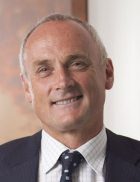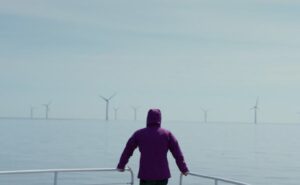The renewables industry has responded angrily to Grant King’s renewed attempts to dilute the renewable energy target, accusing the CEO of Origin Energy of distorting the facts, and taking actions in his own self interest that could result in higher bills for consumers.
Miles George, the CEO of Infigen Energy, the largest owner of wind farms in the country and an emerging developer of solar power, said King – who has waged a campaign against the RET for the last few years- had gone “over the top” in a speech to CEDA earlier this week and made statements that were “just not true.”
George’s comments were made before the government on Thursday announced it would endorse the recommendation of the Climate Change Authority to retain the fixed 41,000GWh target for the RET. But given the uncertainty over the upcoming election and the position of the Coalition, and the possibility that another review could be held in 2014, the same arguments are likely to be rolled out in coming months.
George’s intervention highlights to what extent the renewables industry has been frustrated by the actions of the incumbent industry, but also points to a warning of the rapid changes that are being ignored by utilities – possibly at their peril.
George told an energy conference in Sydney on Wednesday that Origin had invested billions in the gas export industry, and was seeking to protect that investment. “The fact is that the expected huge rise in domestic gas prices to export parity pricing over the next few years will make domestic gas fired power generation prohibitively expensive, and for that reason alone uncompetitive,” George said.
“Independent studies conducted by the Climate Change Authority, among others, have found that increased levels of renewable energy will in fact displace coal fired generation, after gas exporters (including Origin) price themselves out of the domestic electricity generation market.”
George also contested King’s claims that wind generation was adding extra costs on the consumers. He noted that South Australia had already achieved over 20 per cent renewable energy generation on a capacity basis (and more than 25 per cent on a production basis) – and had done so without the addition on any new peaking gas plants to provide reliability.
“Not one MW,” he said. “There is no evidence that wind energy will drive increasing volatility and potential unreliability in the NEM unless that power is firmed by open cycle gas to provide reliability.”
Furthermore, according to Australian Energy Market Operator, the increased level of wind energy deployment in South Australia has reduced the occurrence of high priced volatility events in the electricity system, and lowered the wholesale cost of electricity.
George also noted that there had been no new investment in plant to manage volatility and interruptibility. It had not been needed. These are important points, particularly in the light of renewed attempts by the nuclear lobby to discredit renewables on the basis that they are intermittent.
This week, nuclear lobbyists writing in The Conversation quoted a year-old report from the Nuclear Energy Agency which said the cost of “grid integration” of wind and solar were high – as much as $44/MWh in the case of wind, and $83/MWh in the case of solar – inferring that the same would be the case in Australia.
It was clearly an attempt to discredit a recent Bloomberg New Energy Finance report that said that wind energy was cheaper than new build gas or coal in Australia (and elsewhere – a point recognised by the chairman and CEO of the world’s largest supplier of energy equipment, General Electric, earlier this week).
AEMO, however, in an analysis of the South Australian market, said the cost of “firming” wind had been less than a dollar a MWh – at just 66c/MWh. George noted that wind farm developers usually paid for their own transmission connection. (We’ll have more on the NEA report at a later time).
George said that the renewables industry was particularly concerned by another graph displayed by King on Monday, (seen below) which suggested that there would be little construction of wind farms in coming years, leading to up to 2,000MW of wind to be built in each of four years to reach the target endorsed by the Climate Change Authority.
“This clearly demonstrates what their strategy is, which is to do nothing and cause the problem that they are supposed to deal with,” George said. He said this would ultimately lead to higher costs to consumers.
“Origin has chosen not to go down a path of commitment that would underwrite a smooth new build schedule for renewable energy, instead choosing to use its dominant market position, and the political clout that goes with that status, to browbeat the Australian parliament into a watering down of its obligations under the RET legislation. Will our Parliament (however, it is settled in September) really allow the national interest to be captured in this way?
“The independent Climate Change Authority undertook substantial consultation and commissioned expert studies in its review of the renewable energy target and largely recommended no change to the scheme, highlighting the need to provide investors with certainty.
“Every interested party, including Origin, had an opportunity to make its case to the Authority and it is a disservice to the Authority to suggest as Origin has, that it “skipped an opportunity to review the true cost of the scheme”. I believe that the CCA undertook a thorough review and used all the available evidence in making its determination, including any evidence provided by Origin.”
George said the electricity market is evolving from a centralised thermal fuel model to a more decentralised model with a strong renewable contribution . However, because of consolidation and vertical integration, dominant market power is now held by three big retailers with “deep vested interests in thermal generation that inform how they think the market should evolve. “
And this combination of market power and sunk costs in legacy generation technologies is likely result in consumers paying more for electricity than they needed to.
“Current electricity price signals reflect much higher network cost/investment, the adoption of a price on carbon, and the beginning of the move to export price parity for key thermal generation fuels,” he said .
“Evidence to date suggests that renewables can put downward pressure on these costs. The market can respond to these price pressures but has failed to do so. Consumer education, time of use metering and demand side management are tools readily available to rein in some of these costs but there is little or no incentive for the incumbent business to utilise these.”
He predicted a big change in the industry, with current electricity supply agreements becoming “a thing of the past” with more nimble organisations now moving in and taking the time to understand their customers’ needs. Innovative new entrants are working with customers to find a range of solutions including supply from the grid, demand side management, and embedded generation with financing options.
George also said the RET was established not only to reduce emissions but to “promote the development of the renewable energy industry in Australia, so to look at it on a simple cost of abatement measure is ridiculous.” This was a theme picked up the Clean Energy Council deputy CEO Kane Thornton earlier this week, who said reducing the target as proposed by Origin and others would be disastrous for the more than $10 billion worth of investment already made – and the $18 billion about to come.
George also said the big retailers had benefited from the poor design and implementation of some aspects of the renewable energy scheme, particularly that relating to the solar bonus scheme, where the retailers bought cheap certificates and were allowed by pricing regulators to pass on the full price. “Origin and other retailers have profited greatly from the price differential.”
George also touched on the issue of community acceptance, saying wind farms were typically supported by the vast majority of the local communities where they were are located. “It is a small but vocal minority of city based anti-wind farm crusaders, and their supporters in the fossil fuel industry, that use scare-mongering tactics to grab media headlines,” he said.
But he said that to the extent that such tactics cause problems for the renewable energy industry, the effects will be much worse for the coal seam gas industry where much greater community concerns exist, and the cost of dealing with fugitive methane emissions and risks to groundwater contamination have not yet been satisfactorily resolved.
“The fact is that wind farms are an excellent provider of carbon emission free electrical energy to the grid and comparing a wind farm to a diesel peaker or coal fired power station is akin to comparing an America’s cup yacht to a Jet Ski or an oil tanker,” George said.
“Each serves a different purpose and is effective when deployed for that purpose. A wind farm delivers cheap clean energy when the wind blows, a diesel peaker delivers expensive fossil fuel energy when consumers demand it. As we decarbonise our generation fleet these technologies will combine with others to deliver the least cost solution to the end customer.”









